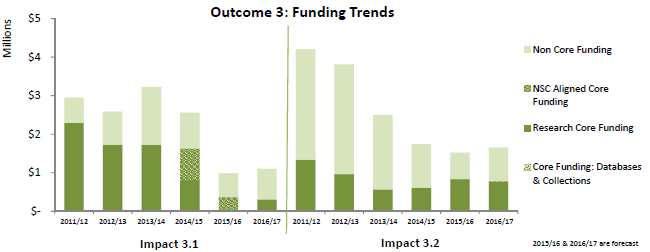National Outcome 3: Greenhouse Gases within Limits
Improved measurement and mitigation of greenhouse gases from the terrestrial biosphere.
Relevant national goals:
- By 2030, New Zealand has reduced its greenhouse gas emissions to 30% below 2005 levels (New Zealand’s 2030 climate change target).
Background
For New Zealand to meet its international greenhouse gas obligations, it is necessary to have a robust inventory of net emissions and carbon storage at a national scale, and appropriate mitigation tools. In July 2015, the New Zealand Government announced that our post-2020 climate change target is to reduce greenhouse gas emissions to 30% below 2005 levels by 2030. This target was tabled at a United Nations meeting in Paris in December 2015 and signed at a ceremony in New York, 22 April, 2016. It will come into force for New Zealand once it has been ratified by at least 55 countries representing at least an estimated 55 per cent of global emissions.
New Zealand will meet its responsibility targets through a mix of domestic emissions reductions, the removal of carbon dioxide by forests, and participation in international carbon markets. It will be important for New Zealand to be able to model the environmental and economic impacts of proposed emissions reduction targets, and have access to effective mitigation options for reducing net emissions. The science challenges are substantial, as are the policy and land management challenges. Collaborative partnerships between research groups, government agencies and the primary industries sector are the key to meeting these challenges and delivering the National Outcome.
Outcome 3 MBIE Strategic Funding

Some MBIE Strategic Funding to this Outcome has been realigned to support related research in Outcomes 2 and 4 where the focus on sustainable management of productive land and soils also supports management of greenhouse gases and soil carbon. In 2016/17, we are continuing this shift and also investing in research that will support on-farm greenhouse gas emissions reductions.
These shifts are well aligned with the National Statement of Science Investment directions of improving New Zealand’s environmental evidence base, and our understanding of environmental opportunities and limits to underpin economic goals, and with balancing productivity and sustainability.
MBIE Strategic Funding of Databases and Collections and associated infrastructure:
Although no MBIE Strategic Funding for Databases and Collections sits within this Outcome, Outcome 3 research programmes draw on the Land Resource Information System (LRIS), the National Soils Database (NSD), and the National Vegetation Survey (NVS).
Impact 3.1
The status and trend of terrestrial greenhouse gas emissions, storage and removal and their drivers are understood and used to report, predict and manage greenhouse gas emissions and removals.
16/17 Research Focus Areas
- Improve national greenhouse gas inventory reporting and forecasting by
- continuing to improve the accuracy of greenhouse gas emissions measurement and modelling
- more accurate scaling-up and mapping of emissions/removals via new technologies and methods
- developing more accurate assessment of on-farm greenhouse gas emissions and removals
- improving advice on carbon stocks in soil, forests and scrubland, and emissions from deforestation.
Impact Key Performance Indicators:
- 70–80% MBIE Strategic Funding of research outputs are on-track or completed.
- 80–90% of Research Focus Area key research initiatives success measures achieved (3-year rolling average, noting that, as a new measure, it will be only partially reported in the first two years).
Impact 3.2
New and improved tools increase terrestrial carbon storage and reduce greenhouse gas emissions.
16/17 Research Focus Areas
- Reduce the greenhouse gas impacts of land management practices by
- improving evaluation of the impact of mitigation options on emissions and removals
- measuring and modelling the potential for pasture systems to optimise soil carbon storage
- improving whole ecosystem modelling of the carbon cycle
- improving understanding of key system responses to climate change (e.g. plant growth to CO2).
Impact Key Performance Indicators:
- 70–80% MBIE Strategic Funding of research outputs are on-track or completed.
- 80–90% of Research Focus Area key research initiatives success measures achieved (3-year rolling average, noting that, as a new measure, it will be only partially reported in the first two years)
Outcome Key Performance Indicators
Measurement of progress towards Outcome 3 is informed by a suite of agency KPIs to which Landcare Research Impacts contribute:
- Improving trends in greenhouse gas emissions and removals in the annual National Greenhouse Gas Inventory (MfE)
- Downward trends in greenhouse gas intensity of the economy by emissions per unit of GDP and emissions per capita (MfE)
